Cottage cheese pasta keeps saving my weeknights — seriously. It’s ridiculously easy, sneakily healthy, and best of all, my picky kid eats it without hesitation. (Yes, miracles do happen.)
When you’re craving something creamy but don’t have time or energy for a from-scratch Alfredo, this dish is your answer. Packed with protein and ready in just 20 minutes, it delivers all the comfort of traditional creamy pasta — no heavy cream or butter needed.
With 28 grams of protein per serving, this high-protein dinner has become my go-to for busy evenings. It’s one of those meals that actually makes me feel good about feeding my family.
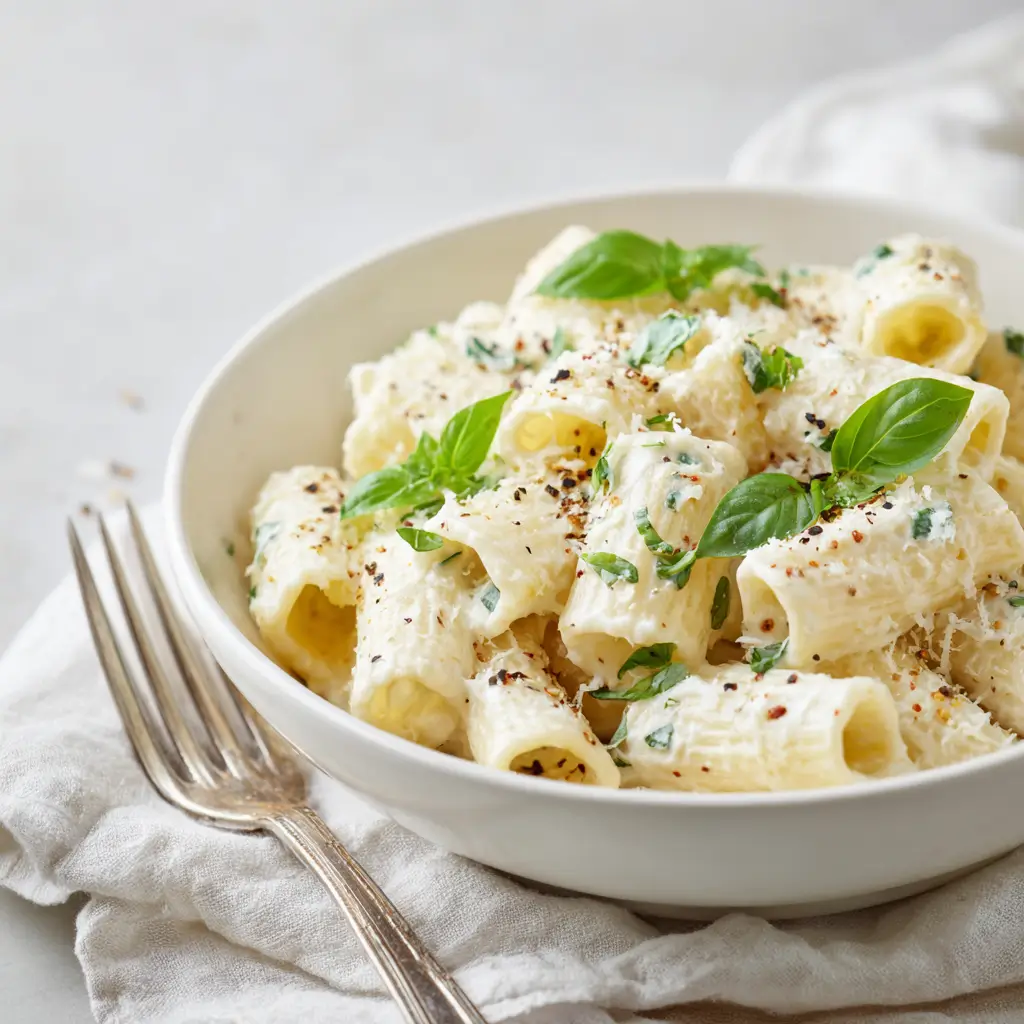
Table of Contents
Table of Contents
Why This Cottage Cheese Pasta Recipe Works
Here’s the truth: Most traditional creamy pasta sauces are deliciously deadly — terrible for your cholesterol and your waistband. This recipe flips the script.
Instead of heavy cream and butter, you get a rich, velvety sauce made from blended cottage cheese — high in protein, low in fat, and shockingly creamy. The magic happens when you puree the cottage cheese until silky smooth. The result? A restaurant-quality sauce that clings to every noodle… without the guilt.
Eat a big bowl and actually feel good afterward — not sluggish or sorry.
What makes this dish a game-changer:
Kid-approved flavor — zero “healthy food” side-eye
28g protein per serving (vs. just 8g in regular creamy pasta)
40% fewer calories than traditional cream-based sauces
Ready in 20 minutes, with minimal cleanup
Ingredients :
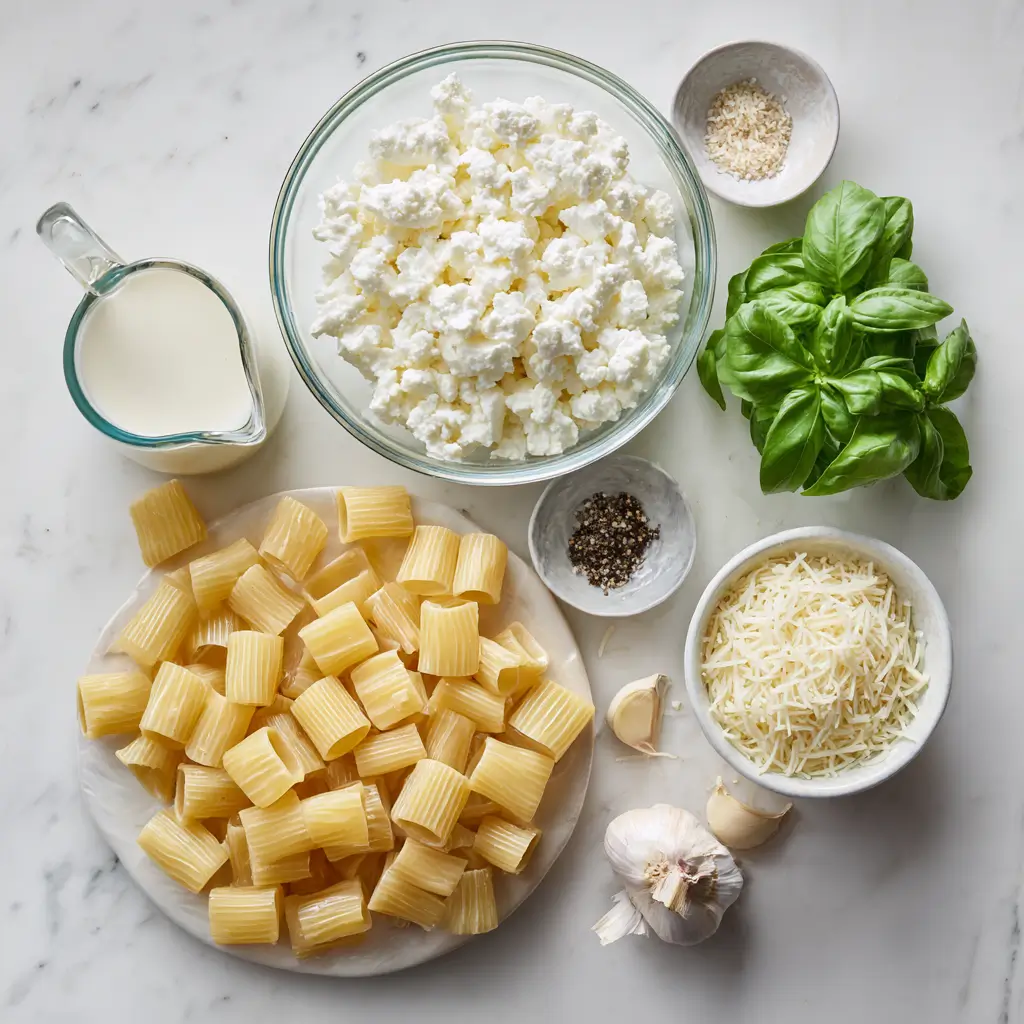
The beauty of this dish lies in its simplicity — you probably already have most of these ingredients in your kitchen. Here’s what you’ll need, and why each one matters:
Main Ingredients :
Cottage Cheese (1 cup)
The star of the creamy sauce. Choose full-fat (4%) for the richest, most alfredo-like texture, or go low-fat for a lighter version. Both blend into a smooth, luxurious sauce — full-fat is ultra-creamy, while low-fat still delivers great flavor with fewer calories. Brands like Good Culture, Daisy, or Aldi’s store-bought options work perfectly.
Pasta (12 oz)
Almost any shape works, but I prefer penne, rigatoni, shells, or spirals — their ridges and curves hold the sauce beautifully. For a protein boost, try chickpea or lentil pasta. It pairs wonderfully with the cottage cheese base and keeps the dish hearty and satisfying.
Parmesan Cheese (¼ cup grated)
Freshly grated parmesan adds a sharp, nutty depth that elevates the mild cottage cheese into something restaurant-worthy. Pre-grated is fine in a pinch, but fresh always brings better flavor and melt.
Flavor Enhancers
Garlic (1 clove, optional)
A single clove blended into the sauce adds subtle depth without overpowering. Skip it if you’re not a fan — the sauce still shines.
Salt and Black Pepper
Don’t underestimate seasoning! Cottage cheese is mild, so a good pinch of salt and a crack of pepper make all the difference between bland and brilliant.
Pasta Water or Milk (¼ cup)
Your secret weapon for perfect texture. Starchy pasta water helps the sauce cling to every noodle, while a splash of milk adds extra creaminess if needed.
Optional Add-ins
- Steamed peas or broccoli
- Wilted spinach
- Roasted vegetables (like zucchini or cherry tomatoes)
- Grilled chicken or turkey for extra protein
- Fresh herbs like basil or parsley for a bright finish
How to Make Cottage Cheese Pasta (Step-by-Step)
Making this creamy, protein-packed dish is as easy as everyone says — no fancy techniques required. The secret? Timing your pasta and sauce so they come together perfectly. Here’s how:
Step 1: Start Your Pasta Water (5 minutes)
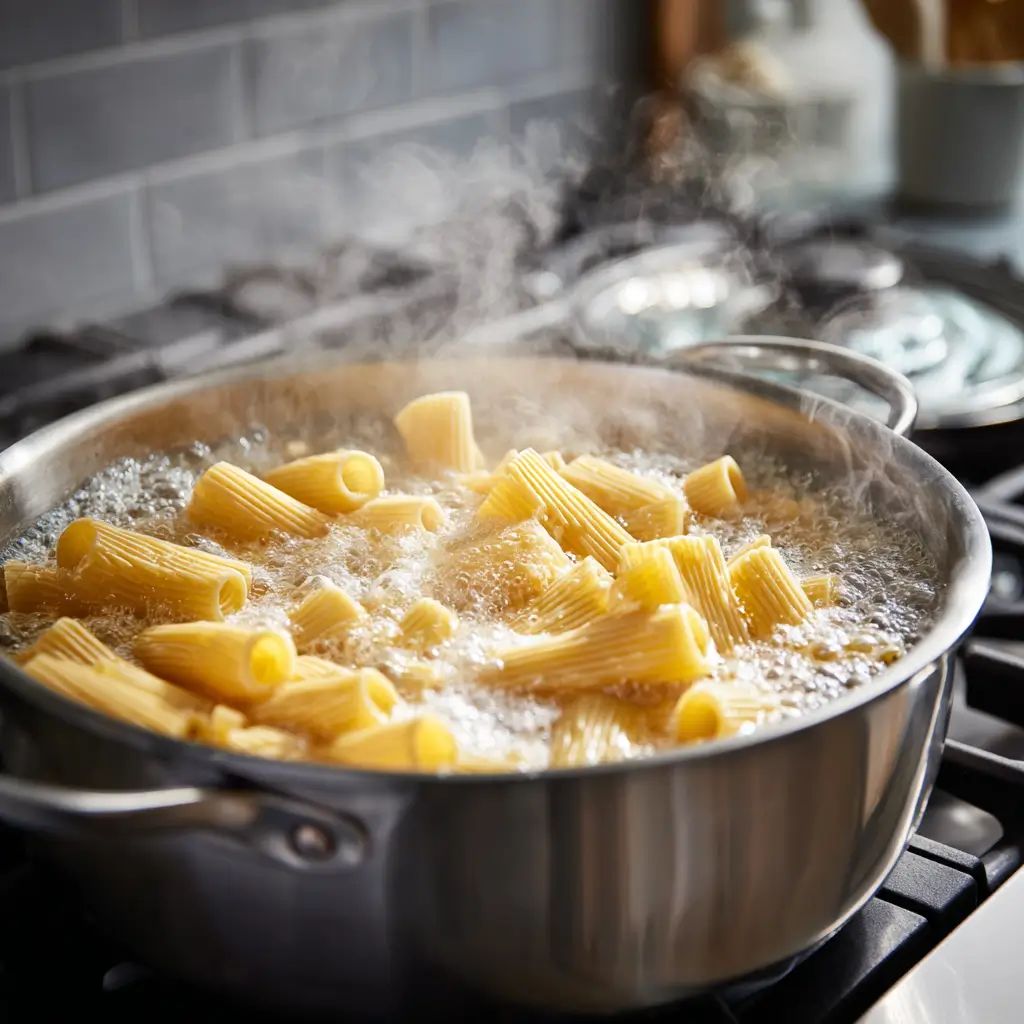
Fill a large pot with water and add 1 tablespoon of salt per quart. It might seem like a lot, but well-salted water is essential for building flavor from the start. Bring it to a rolling boil — this usually takes 8–10 minutes, depending on your stove.
Step 2: Cook the Pasta (8–12 minutes)
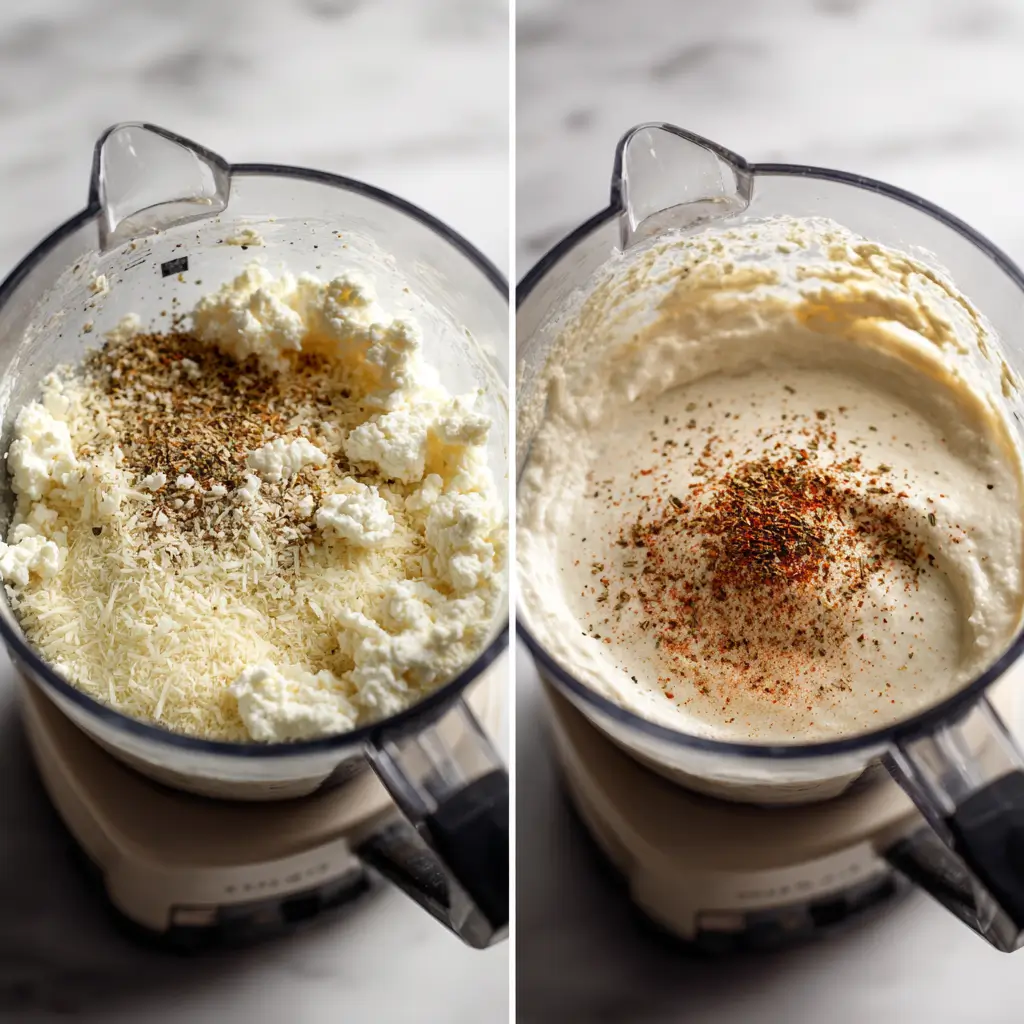
Once boiling, add your pasta and cook until al dente — just tender with a slight bite. This is key, since the noodles will finish cooking in the sauce. Before draining, reserve ½ cup of starchy pasta water. It’s liquid gold for helping your sauce cling to every noodle.
Drain the pasta and set aside (don’t rinse!).
Step 3: Blend the Sauce (3 minutes)
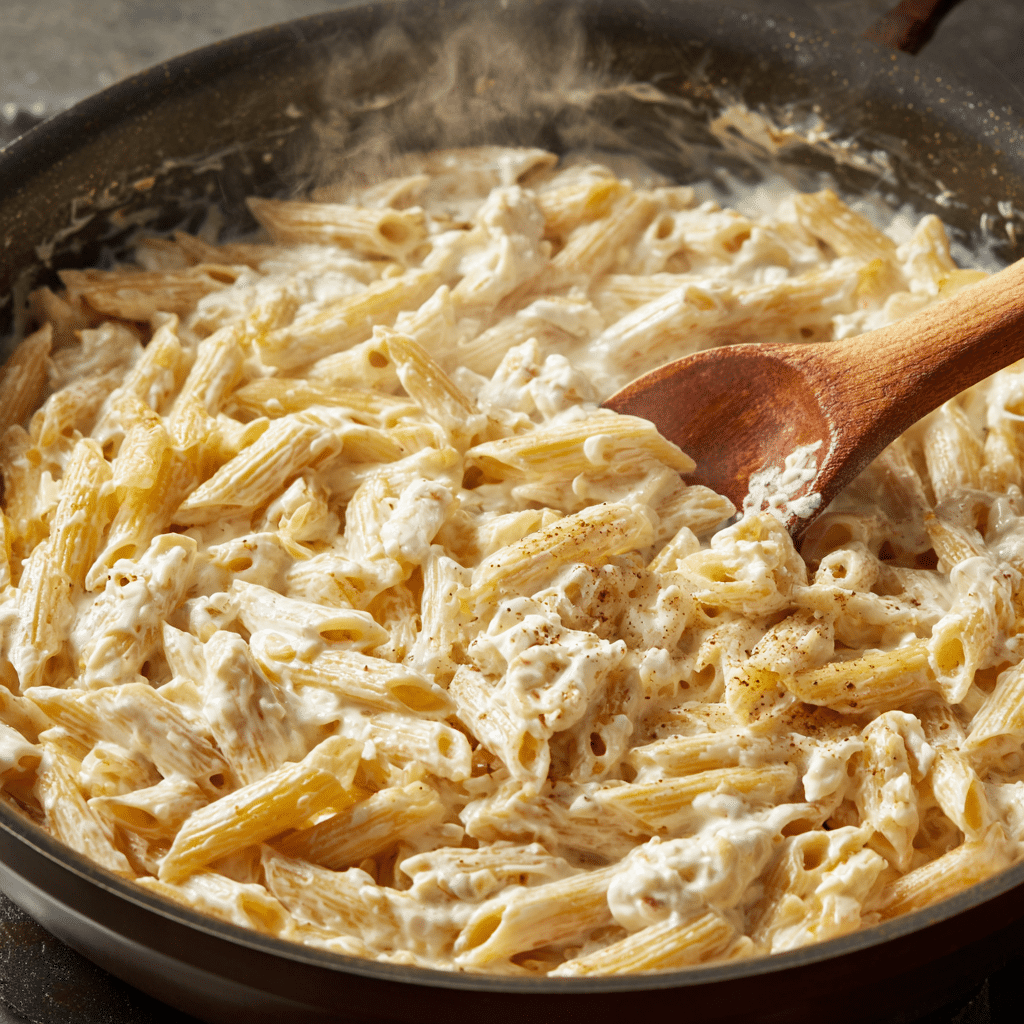
While the pasta cooks, add cottage cheese, parmesan, garlic (if using), salt, and pepper to a high-speed blender or food processor. Blend for at least 60 seconds, until completely smooth and silky. Any lumps will stand out, so blend thoroughly.
Pro tip: No high-speed blender? Use an immersion blender in a deep bowl — it works just as well.
Step 4: Combine Everything (2 minutes)
Return the drained pasta to the pot or transfer to a skillet over low heat. Pour in the blended sauce and gently stir to coat. Add 2–3 tablespoons of the reserved pasta water to loosen the sauce and help it emulsify.
⚠️ Keep the heat low — high temperatures can cause the cottage cheese to separate, leading to a grainy texture.
Step 5: Final Touches
If you’re adding veggies like peas, spinach, or roasted tomatoes, fold them in now. The residual heat will warm them perfectly. Taste and adjust seasoning — a pinch more salt or pepper can make all the difference.
Serve immediately, with extra parmesan or fresh herbs on top if you like.
8 Ways to Customize Your Cottage Cheese Pasta
One of the best things about this creamy, high-protein dish is how endlessly adaptable it is. Once you’ve mastered the base recipe, you can create a whole week’s worth of dinners with simple twists. Here are my family’s favorites:
Protein-Packed Variations
Turkey & Onion
Brown 1 lb of ground turkey with diced onions until golden. Stir into your finished dish for a hearty, savory upgrade.
Chicken & Herb
Add grilled chicken strips and a generous handful of fresh basil for a light, flavorful twist.
Italian Sausage
Cook crumbled sausage (mild or spicy), then fold it into the warm pasta. It adds bold flavor that adults love — kids usually approve too!
Veggie-Loaded Options
Garden Mix
Stir in steamed broccoli, peas, and carrots for a colorful, nutrient-rich version the whole family can enjoy.
Spinach & Sun-Dried Tomato
Wilt fresh spinach into the hot pasta, then add chopped sun-dried tomatoes for a tangy, Mediterranean flair.
Roasted Vegetable
Toss in roasted zucchini, bell peppers, and cherry tomatoes. Their caramelized flavor pairs beautifully with the creamy sauce.
Flavor Twist Variations
Spicy Kick
Add red pepper flakes, a dash of hot sauce, or diced jalapeños for a bold, warming version (a favorite in our house!).
Lemon Herb
Brighten things up with lemon zest, fresh dill, and a squeeze of juice. It’s fresh, zesty, and perfect for spring or summer.
Each variation keeps the same smooth, protein-rich base — just switch up the add-ins to create a totally different meal. My kids stick to the classic version, while my husband can’t get enough of the spicy sausage twist.
Equipment You’ll Need for Perfect Cottage Cheese Pasta
Essential Equipment:
- Large pot for pasta (at least 4-quart capacity)
- High-speed blender or food processor (for smooth cottage cheese sauce)
- Large skillet or the pasta pot for combining
- Measuring cups and spoons
Nice to Have:
- Immersion blender (great alternative for cottage cheese sauce)
- Pasta fork or tongs for serving
- Fine mesh strainer for pasta water
Equipment Tips for Cottage Cheese Pasta: If your blender struggles with the cottage cheese, add a tablespoon of milk or pasta water to help it blend smoothly. A food processor works just as well as a blender for cottage cheese pasta sauce.
Storage and Reheating Your Cottage Cheese Pasta
Cottage cheese pasta keeps pretty dang well – honestly, it’s one of my favorite meal prep solutions. Here’s everything you need to know about storing and reheating:
Refrigerator Storage:
Store leftover cottage cheese pasta in airtight containers for up to 4 days. The sauce might thicken slightly, but it reheats beautifully. I often make a double batch of cottage cheese pasta on Sunday for easy weeknight dinners.
Reheating Methods:
Microwave Method: Add 1-2 tablespoons of milk or water to the cottage cheese pasta, then microwave in 30-second intervals, stirring between each interval. This prevents the sauce from separating.
Stovetop Method: Heat cottage cheese pasta in a skillet over low heat, adding a splash of milk or pasta water to loosen the sauce. Stir gently until warmed through.
Pro tip: If your reheated cottage cheese pasta sauce looks separated, add a tablespoon of milk and blend with an immersion blender for 10 seconds. It’ll be smooth as new!
Freezing Cottage Cheese Pasta:
While cottage cheese pasta can be frozen for up to 3 months, the texture changes slightly upon thawing. The pasta tends to absorb more sauce, so you may need to add extra milk when reheating. For best results, I recommend freezing the cottage cheese sauce separately from the pasta.
Nutritional Benefits of Cottage Cheese Pasta
Let’s talk about why cottage cheese pasta is such a nutritional powerhouse. This isn’t just comfort food – it’s actually doing your body some serious favors.
Nutrition Facts (Per Serving):
- Calories: 420
- Protein: 28g (56% daily value)
- Carbohydrates: 52g
- Fat: 8g
- Fiber: 3g
- Calcium: 15% daily value
- Sodium: 680mg
Why Cottage Cheese Pasta is Nutritionally Superior:
High-Quality Protein: The cottage cheese in this recipe provides all essential amino acids, making it a complete protein. This helps with muscle maintenance, satiety, and stable blood sugar levels.
Lower in Calories: Compared to traditional cream-based pasta, cottage cheese pasta saves you about 200-300 calories per serving without sacrificing taste or satisfaction.
Calcium Boost: One serving provides 15% of your daily calcium needs, supporting bone health and muscle function.
B Vitamins: Cottage cheese is rich in B12, riboflavin, and other B vitamins that support energy metabolism and nervous system function.
For more details on cottage cheese’s nutritional benefits, check out my guide on cottage cheese for bodybuilding and cottage cheese for weight loss.
Troubleshooting Common Cottage Cheese Pasta Problems
Even simple recipes like cottage cheese pasta can have their hiccups. Here are the most common issues and how to fix them:
Problem: Lumpy Cottage Cheese Sauce
Solution: Your cottage cheese wasn’t blended enough. Transfer the sauce back to your blender and process for another 30-60 seconds until completely smooth. For future batches, blend cottage cheese pasta sauce for at least 60 seconds initially.
Problem: Sauce Too Thick
Solution: Add pasta water or milk, one tablespoon at a time, until your cottage cheese pasta reaches the desired consistency. The sauce should coat the pasta without being gloppy.
Problem: Sauce Too Thin
Solution: Add more cottage cheese or a tablespoon of grated parmesan to thicken. You can also simmer the cottage cheese pasta on low heat for 1-2 minutes to reduce excess liquid.
Problem: Sauce Separates or Curdles
Solution: This usually happens from too much heat. Remove from heat immediately and stir in a tablespoon of cold milk. For severely separated cottage cheese pasta sauce, blend again with an immersion blender.
Problem: Bland Flavor
Solution: Cottage cheese pasta needs proper seasoning. Add more salt, pepper, or parmesan cheese. A squeeze of lemon juice can also brighten the flavors significantly.
What to Serve with Cottage Cheese Pasta
Cottage cheese pasta is hearty enough to stand alone, but these sides create a complete, restaurant-quality meal:
Light & Fresh Sides:
- Simple Green Salad: Mixed greens with lemon vinaigrette balances the richness
- Roasted Vegetables: Asparagus, Brussels sprouts, or green beans
- Caprese Salad: Fresh tomatoes and mozzarella complement cottage cheese pasta beautifully
Heartier Accompaniments:
- Garlic Bread: Perfect for soaking up any extra cottage cheese pasta sauce
- Caesar Salad: The bold flavors pair wonderfully with creamy cottage cheese pasta
- Roasted Broccoli: High in fiber and adds great color to your plate
Wine Pairings:
- White Wine: Pinot Grigio or Chardonnay complement cottage cheese pasta nicely
- Light Red: Pinot Noir works if you prefer red wine with pasta
- Non-Alcoholic: Sparkling water with lemon or a light iced tea
Frequently Asked Questions About Cottage Cheese Pasta
Does the cottage cheese taste strong in the pasta?
Nope! Once you blend cottage cheese smooth and combine it with parmesan and seasonings, the flavor becomes mild and creamy. Most people can’t identify cottage cheese as the base of this pasta sauce – they just taste delicious, creamy cottage cheese pasta.
Is cottage cheese pasta good for meal prep?
Absolutely! Cottage cheese pasta keeps beautifully in the fridge for up to 4 days and honestly tastes just as good reheated (sometimes even better as the flavors meld). I make it every Sunday for easy weeknight dinners.
Can I use any pasta shape I like?
Definitely! While I prefer shapes like penne, rigatoni, or shells because they hold the cottage cheese sauce well, any pasta works. Even spaghetti or fettuccine make delicious cottage cheese pasta.
Will picky eaters notice it’s made with cottage cheese?
Probably not, especially if you blend the cottage cheese completely smooth and add parmesan cheese. The texture and flavor of cottage cheese pasta is remarkably similar to traditional cream sauces.
Is full-fat or low-fat cottage cheese better for this recipe?
Both work beautifully! Full-fat cottage cheese creates a slightly creamier sauce that’s closer to traditional alfredo, while low-fat cottage cheese still produces delicious, creamy cottage cheese pasta with fewer calories. Try both and see which you prefer.
More Cottage Cheese Recipes You’ll Love
If you’re loving this cottage cheese pasta, you need to try these other cottage cheese recipes that have become staples in my kitchen:
- Banana Cottage Cheese Pancakes – Next-level breakfast that tastes like dessert
- Buffalo Chicken Dip with Cottage Cheese – Game day favorite with a protein boost
- Cottage Cheese Alfredo Pasta – Another take on creamy cottage cheese pasta
- More high-protein dinner ideas in my cottage cheese for bodybuilding guide
Ready to Make the Best Cottage Cheese Pasta?
Listen, cottage cheese pasta really is as easy as everyone claims. One blender, one saucepan, and dinner’s basically served. The best part? You’ll feel good about feeding this to your family, and they’ll actually ask for seconds.
This cottage cheese pasta recipe has become our go-to weeknight meal because it hits all the marks: quick, healthy, delicious, and kid-approved. Once you try this creamy, protein-packed cottage cheese pasta, traditional cream sauces will seem unnecessarily heavy and complicated.
Give this cottage cheese pasta recipe a spin – you’ll be surprised how good healthy comfort food can taste!
Print
Cottage Cheese Pasta
- Total Time: 17 minutes
- Yield: 4 servings
Description
A creamy, protein-packed pasta made with blended cottage cheese, parmesan, and perfectly cooked pasta, customizable with vegetables, proteins, or herbs.
Ingredients
- 1 cup cottage cheese (full-fat or low-fat)
- 12 oz pasta (rigatoni, penne, shells, or spirals)
- 1/4 cup grated parmesan cheese
- 1 clove garlic (optional)
- Salt, to taste
- Black pepper, to taste
- 1/4 cup pasta water or milk
- Optional add-ins: steamed peas, broccoli, wilted spinach, roasted vegetables, grilled chicken or turkey, fresh herbs
Instructions
- Fill a large pot with water, add 1 tablespoon of salt per quart, and bring to a rolling boil.
- Add pasta and cook according to package directions until al dente. Reserve 1/2 cup pasta water before draining.
- In a blender or food processor, combine cottage cheese, parmesan, garlic (if using), salt, and pepper. Blend until completely smooth (about 60 seconds).
- Return drained pasta to the pot or a skillet over low heat. Pour in the cottage cheese sauce and stir to coat. Add 2-3 tablespoons reserved pasta water for desired consistency.
- Keep heat low to avoid sauce separation. Fold in any optional vegetables or proteins.
- Taste and adjust seasoning before serving.
Notes
Blend the sauce until perfectly smooth for the best creamy texture. Avoid high heat to prevent separation.
- Prep Time: 5 minutes
- Cook Time: 12 minutes
- Category: Main Course
- Method: Stovetop
- Cuisine: American
